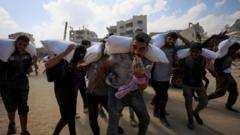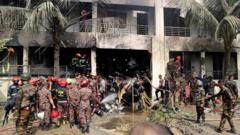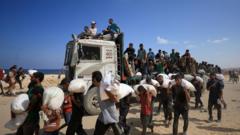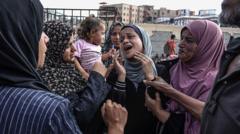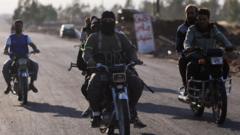Two deadly incidents in Gaza over the weekend starkly illustrate the perilous nature of food distribution amidst ongoing conflict, raising urgent concerns over civilian safety.
Deadly Aid Distribution Incidents Highlight Risks in Gaza

Deadly Aid Distribution Incidents Highlight Risks in Gaza
Recent shootings reveal the deadly consequences of food distribution methods in Gaza, exposing the dire situation faced by civilians.
Over the weekend, two tragic incidents underscored the extreme risks associated with food aid distribution in Gaza, where escalating violence complicates efforts to alleviate hunger. On Saturday, Israeli soldiers opened fire on civilians near food distribution sites set up by private contractors supported by Israel. The following day, another shooting occurred as individuals rushed to claim supplies from a United Nations convoy targeted at areas controlled by Hamas.
Supporters of the Israel-backed distribution system highlighted the failures of the U.N.-led efforts, while those in favor of the U.N. approach pointed to the Saturday shooting incident as evidence of the shortcomings in Israel’s strategy. Israeli officials argue that placing aid distribution in areas outside Hamas’s influence is intended to prevent opportunistic looting of supplies by militants and civilians alike. However, critics assert this tactic forces desperate individuals to cross military lines, thereby heightening their vulnerability.
Three overarching issues contribute to the heightened dangers surrounding both approaches to aid distribution. Firstly, the Israeli military responded with live ammunition to crowd unrest rather than employing nonlethal measures for crowd management. Secondly, the scarcity of food due to an 80-day blockade has left civilians in dire straits, often risking their lives for access to food. Thirdly, after nearly two years of conflict, governance in Gaza has effectively collapsed, with Hamas unable to maintain social services or law enforcement in most regions.
Although Israel has dismantled much of Hamas's leadership and infrastructure, Prime Minister Benjamin Netanyahu has refrained from establishing a transitional governance framework, opting instead for a strategy focused solely on defeating Hamas. Critics argue that effective long-term solutions to end the cycle of violence require a viable plan for governance in Gaza beyond military action against militants.
In summary, urgent consideration is needed to address the deteriorating conditions in Gaza and the principle of civilian protection during aid distribution. The ongoing uncertainties render the situation increasingly precarious as efforts to combat hunger are compounded by violence and governance failure in the region.
Supporters of the Israel-backed distribution system highlighted the failures of the U.N.-led efforts, while those in favor of the U.N. approach pointed to the Saturday shooting incident as evidence of the shortcomings in Israel’s strategy. Israeli officials argue that placing aid distribution in areas outside Hamas’s influence is intended to prevent opportunistic looting of supplies by militants and civilians alike. However, critics assert this tactic forces desperate individuals to cross military lines, thereby heightening their vulnerability.
Three overarching issues contribute to the heightened dangers surrounding both approaches to aid distribution. Firstly, the Israeli military responded with live ammunition to crowd unrest rather than employing nonlethal measures for crowd management. Secondly, the scarcity of food due to an 80-day blockade has left civilians in dire straits, often risking their lives for access to food. Thirdly, after nearly two years of conflict, governance in Gaza has effectively collapsed, with Hamas unable to maintain social services or law enforcement in most regions.
Although Israel has dismantled much of Hamas's leadership and infrastructure, Prime Minister Benjamin Netanyahu has refrained from establishing a transitional governance framework, opting instead for a strategy focused solely on defeating Hamas. Critics argue that effective long-term solutions to end the cycle of violence require a viable plan for governance in Gaza beyond military action against militants.
In summary, urgent consideration is needed to address the deteriorating conditions in Gaza and the principle of civilian protection during aid distribution. The ongoing uncertainties render the situation increasingly precarious as efforts to combat hunger are compounded by violence and governance failure in the region.


